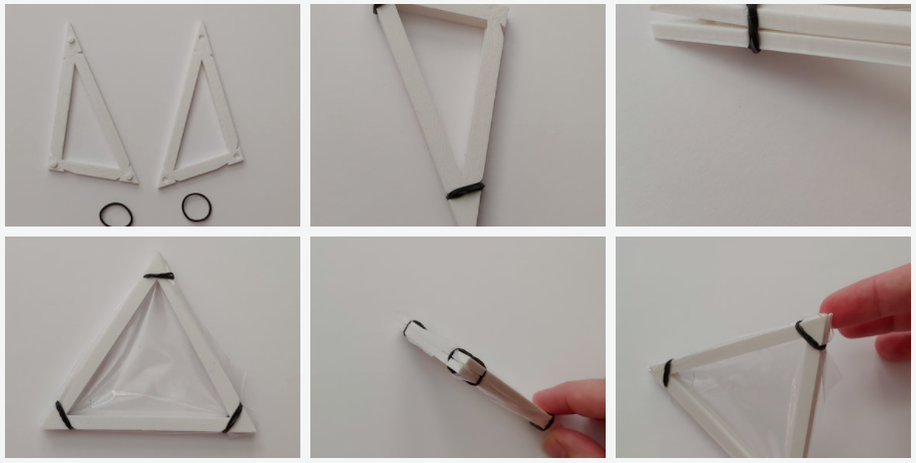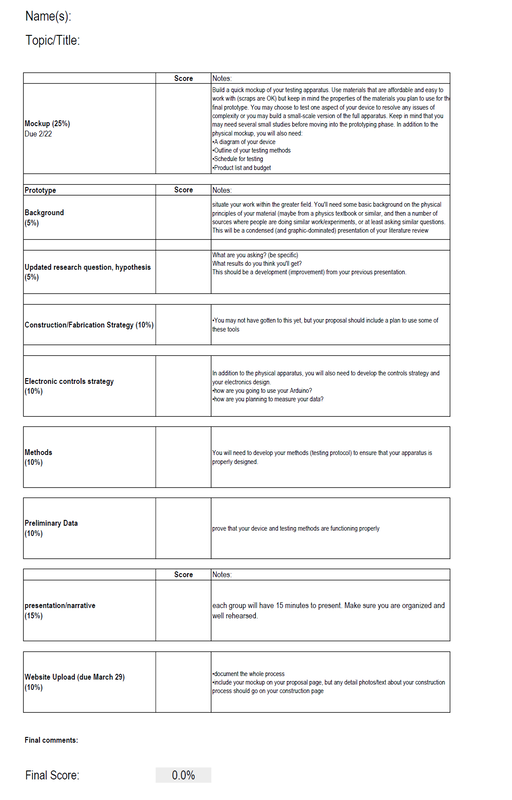Image by Dani Scaccia
Assignment 2: Mockup & Prototype
Part 1: Mockup (1 week)
Mockups are commonly used in construction to test new ideas, understand the way materials come together, or just to give the owner or architect one more opportunity to make improvements. They can also be used for performance testing (such as water penetration at window installations) and help inform the subcontractors how details are to be installed. In product design, mockups are often used to test ideas at a small scale before moving forward with full-scale fabrication. They can also be used to test materials and design details which are difficult to visualize in a digital model.
Build a quick mockup of your testing apparatus. Use materials that are affordable and easy to work with (scraps are OK) but keep in mind the properties of the materials you plan to use for the final prototype. You may choose to test one aspect of your device to resolve any issues of complexity or you may build a small-scale version of the full apparatus. Keep in mind that you may need several small studies before moving into the prototyping phase. In addition to the physical mockup, you will also need:
Due February 22 (post on website on ‘proposal’ page and bring to class)
Part 2: Prototype (5 weeks)
Responding to the successes and failures of your mockup, construct a prototype of your testing apparatus. Though this will be your ‘final’ product for the semester, it should not be considered a ‘precious’ object. It will likely need to adapt as you begin to collect data.
In addition to the physical apparatus, you will also need to develop the controls strategy and your electronics design. We will talk more about this during class and will also dedicate two weeks to basic electronics design during weeks 7/8. Finally, you will also need to develop your methods (testing protocol) to ensure that your apparatus is properly design.
Presentation (presented in class March 22)
(you can prepare a PDF, PPT, or present directly off your website)
Each team will have 15 minutes to present
Due: Tuesday, March 29th at 2:30 PM (upload to website)
Mockups are commonly used in construction to test new ideas, understand the way materials come together, or just to give the owner or architect one more opportunity to make improvements. They can also be used for performance testing (such as water penetration at window installations) and help inform the subcontractors how details are to be installed. In product design, mockups are often used to test ideas at a small scale before moving forward with full-scale fabrication. They can also be used to test materials and design details which are difficult to visualize in a digital model.
Build a quick mockup of your testing apparatus. Use materials that are affordable and easy to work with (scraps are OK) but keep in mind the properties of the materials you plan to use for the final prototype. You may choose to test one aspect of your device to resolve any issues of complexity or you may build a small-scale version of the full apparatus. Keep in mind that you may need several small studies before moving into the prototyping phase. In addition to the physical mockup, you will also need:
- A diagram of your device
- Outline of your testing methods
- Schedule for testing
- Product list and budget
Due February 22 (post on website on ‘proposal’ page and bring to class)
Part 2: Prototype (5 weeks)
Responding to the successes and failures of your mockup, construct a prototype of your testing apparatus. Though this will be your ‘final’ product for the semester, it should not be considered a ‘precious’ object. It will likely need to adapt as you begin to collect data.
In addition to the physical apparatus, you will also need to develop the controls strategy and your electronics design. We will talk more about this during class and will also dedicate two weeks to basic electronics design during weeks 7/8. Finally, you will also need to develop your methods (testing protocol) to ensure that your apparatus is properly design.
Presentation (presented in class March 22)
(you can prepare a PDF, PPT, or present directly off your website)
Each team will have 15 minutes to present
- Updated research question and hypothesis
- Summary of background (explain the work in the field)
- Construction/fabrication strategy
- Electronic controls strategy
- Methods
- Preliminary data (prove it works)
Due: Tuesday, March 29th at 2:30 PM (upload to website)

